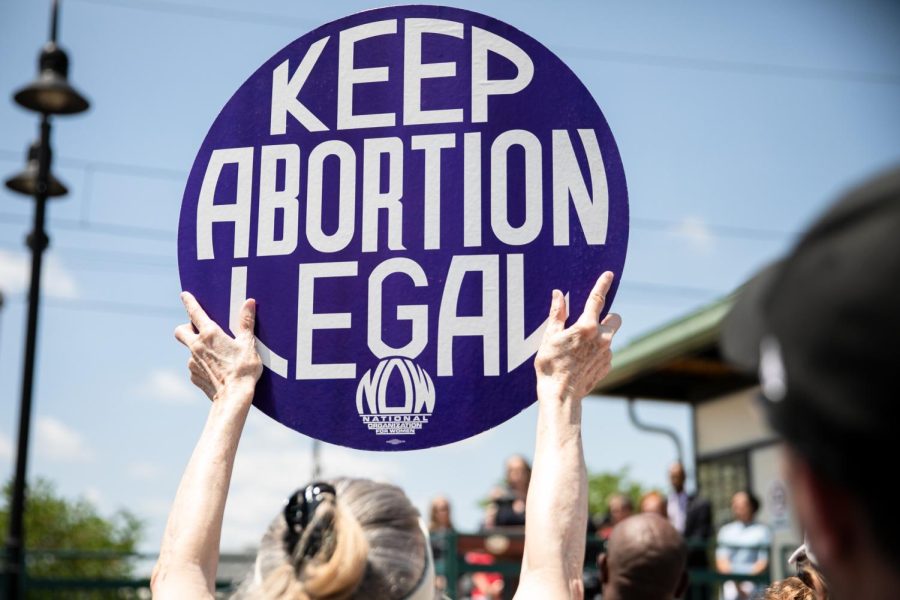Americans must make their voices heard in the controversy surrounding Roe v. Wade
May 13, 2022
A leaked draft of the United States Supreme Court opinion on the Dobbs v. Jackson Women’s Health Organization case recently sent shockwaves throughout the country.
The majority opinion stated in the draft, written by Justice Samuel Alito, seeks to overturn Roe v. Wade, a landmark decision that has ensured abortion as a protected federal constitutional right for the past 50 years, according to documents obtained by Politico.
Though the Supreme Court would like the public to believe that it is insulated from external influences, public scrutiny has forced the hand of justices plenty of times in the past.
With pressure mounting following the leak, it will likely happen again. However, it’s up to the people to ensure it.
Women, the time to act is now. The time to mobilize, to speak up, to flash a tall, proverbial middle finger to the patriarchy through protest and resistance is undeniably, inescapably now.
Right now, the leaked document is just a draft. However, if codified, this decision will stomp on the reproductive rights of millions of women.
The opinion would not ban abortion nationwide but instead allows states to decide whether to drastically restrict or even ban abortion for themselves.
Currently, 58% of American women of reproductive age live in states that are “hostile” to abortion, according to The Guttmacher Institute.
Many such states have “trigger laws” that would go into effect immediately if Roe were overturned.
In some places, these statutes, though currently unenforceable, contain pre-Roe abortion bans. Other laws express intent to come down harder on abortion, if permitted by the Supreme Court.
This means, if the conservative majority gets their way, all women nationwide will feel the fingers of bureaucracy itching at their necks. But approximately 40 million will have already started to choke.
One gradual consequence for states that continue to permit abortions is an overwhelming influx of patients seeking care.
In a letter to Congress, New York Gov. Kathy Hochul wrote New York can expect an “11 to 13% increase in out-of-state patients traveling to New York for abortion care,” if Roe is overturned.
This would have catastrophic consequences for a health care system that’s already facing staffing and capacity shortages.
Additionally, the revocation of protections granted under Roe would disproportionately affect what’s already the most marginalized group in the United States — women of color.
Black and Hispanic women get abortions and experience poverty at a far higher rate than their peers, according to The Associated Press.
If legal, safe abortions were banned in their state, women of color would have much more difficulty traveling to obtain one elsewhere.
The consequences of a Roe-less world are more far-reaching than abortion.
The landmark case also secured its place in history textbooks because of its determination that a women’s right to privacy was violated.
“This right of privacy … is broad enough to encompass a woman’s decision whether or not to terminate her pregnancy. The detriment that the State would impose upon the pregnant woman by denying this choice altogether is apparent,” the ruling said.
Thus, the revocation of abortion rights could have broader implications regarding the government’s stance on decisional autonomy.
The politicization of women’s bodies means spheres where privacy is highly valued, such as the bedroom, the doctor’s office or even the Internet, are not immune to regulation.
It means that by signing off on one backward, retrogressive piece of legislature, the Supreme Court could knock down the ladder to self-autonomy Americans have been adding rungs to since the drafting of the U.S. Constitution.
There’s only one way to stop them. They need to hear us scream.
For several decades, political scientists have collected substantial evidence proving the hypothesis that the Supreme Court reacts to public opinion.
The most plausible theory is, public opinion might influence who is nominated and confirmed, therefore incentivizing justices to align their stances with the majority.
In the same vein, a psychosocial explanation holds that individuals with moderate views tend to shift their opinion in response to information about how others perceive them.
But most interestingly, the Supreme Court must recognize that the execution of a decision relies heavily on the cooperation of other institutional actors.
For instance, it should have a vested interest in whether a decision is interpreted correctly or is likely to be overturned by Congress.
It follows that some non-institutional actors, such as medical practices or advocacy groups, might also be able to leverage the threat of noncompliance to sway the court’s decision.
Time is of the essence. There’s only hope for a favorable outcome in June if concerned Americans loudly demonstrate their noncompliance by protesting, writing to elected officials and donating to abortion funds.
We need to come together and decry this despicable piece of potential legislation. We need the Supreme Court to understand that women’s rights are human rights and that their repudiation will not be tolerated.








